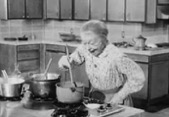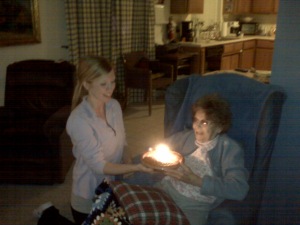
5 and a half years ago, I lost my mother to a very normal death. She was 88. She had been a 1/2 pack a day smoker for 5 decades. One chronic condition – a low platelet count – had dogged her for 40 years, with no ill effects until the last couple years of her life, when periodically she would become “a quart low” and we’d traipse to the ER for a transfusion and diuresis which would make everything better for several months. In going through old emails this morning, I found a letter I wrote to friends of mine during my mother’s last week as I struggled with bearing witness to her end of life transition. It is raw, but I think in that, shares well what normal end of life decline is like for both a loving daughter and her mother. I share it today, after spending some time listening to and reading from David Kessler’s works – knowing that we have little that prepares us for what a normal, uncomplicated end of life process looks like. In a webinar of his, he shares the story of a person telling of the death of a family member, how horrible it was for them. Kessler comments that it was actually quite a normal process they witnessed. I share with you today what “normal” can look like, and the confusion and uncertainty it brings us.
Death is not easy when we have access to technology and drugs that can indefinitely prolong arrival at it’s door. In the end, however, it is where we will all arrive.
Thanks, dear readers, for bearing with these musings as we approach the autumn of the year. May there be peace or comfort in my words – now or later, whenever you need them.
Katherine
 Good morning, my dear friends. I’m writing to you because I’ve been holding a “group conversation” in my head this morning, and realized I really could open it up to you all for us to muck around in a bit, grow and think and philosophize, if you have the energy. It is about the process I am working through with my mom’s end of life. That being said, if you aren’t up to the topic, it’s ok to stop reading here. (you have been warned). I find that I need my “sisters” for a reality check and I needed to journal and talk and do that better when I can imagine you responding and offering the wisdom you have acquired in your collective years. We will all have to walk through this place, let us see what we can glean from each other for tools to help us on our way.
Good morning, my dear friends. I’m writing to you because I’ve been holding a “group conversation” in my head this morning, and realized I really could open it up to you all for us to muck around in a bit, grow and think and philosophize, if you have the energy. It is about the process I am working through with my mom’s end of life. That being said, if you aren’t up to the topic, it’s ok to stop reading here. (you have been warned). I find that I need my “sisters” for a reality check and I needed to journal and talk and do that better when I can imagine you responding and offering the wisdom you have acquired in your collective years. We will all have to walk through this place, let us see what we can glean from each other for tools to help us on our way.
I, who always thought myself a midwife “one who ushers souls both in and out” is finding I am unexpectedly ill-prepared for the changes happening with my mother. I realized this morning that I don’t have a vocabulary for it, this process of un-change that is occurring. Indeed, it seems where I once thought death the “flip side” of birth, I am now thinking it is the “un” side. Having framed most of my adult experiences and passages in terms of labor, delivery, birth and postpartum, I am at a loss, now that I cannot do so. This is so much bigger and more fragmented than birthing, which now seems so predictable and linear. We have documentable steps in the birth process, though few women follow the text book design, we know generally what markers to look for to alert us to an acceleration of the process or dystocia. In the end, we know there will be an out-come, an arrival. In 90+% of those births, there will be great joy and celebration, in others, guilt and sadness.
But what of death? What of the process of dying? It is decidedly not linear, except in that we know it is our ultimate destination, having been born. I am struggling this morning with language and process. Death has no “out-come”; but no “in-go” either, except in the turning inward that those around the dying one revert to for solace and silence. I realized this morning that all my encounters with death intimate to me have been unexpected and dramatic (traumatic). The onset of death was sudden with no time to watch, to bear witness to the slow defragmentation that dying seems to be. I have no predictors, no milestones upon this journey that let me know where we are on the map — closer to town, lost in the woods, stuck in mire? Perhaps it doesn’t matter where we are, we are there anyway, and we know it.
I feel ill-equipped to help my family (children, spouse, siblings, aunts and uncles) for lack of knowing. I know that we (my mother and I/us) are progressing away from something — her health and her vitality, her physical ability, her quick and witty responses to humor or her acerbic response to the news or politics. The fire of her argumentative nature is dowsed, her independence and will to decide important things for herself, put away in a chest probably not to be fully opened again. (She does draw this mantle out periodically, when it seems least likely she will, and then I stand with my mouth agape and wondering how I erred as she, with energetic resolve, lets the social worker or caregiver know that I have made the wrong assumption or decision about her care). Lack of predictable response on my mother’s part is a large measure of what keeps me off-balance in this precarious walk. She wants me to make important decisions about her treatment (though on hospice in all other respects, we are still making the final — and it will no doubt be final — decision about whether to treat her mortally low platelets anymore, and she asks me to make that decision for her, stating it is too big for her to make). I don’t want to be the “parent” in this conversation….I want to be the daughter passively along for the ride, not the driver deciding which road we take through these uncharted lands.
I have no language of death or the slow defragmentation that I am seeing now, where the loss of strength and increase of pain have no etiology, no treatment, no diagnosis — only the persistent question “if we do invasive diagnostic procedures, and we find something (MS, ovarian cancer, gallstones, kidney stones, etc), what would we do with that information besides continue to keep your mother comfortable?” My mother is a frail, 88 (on Thursday) year old woman who smoked for 5 decades and has had uncontrolled (though mildly so) diabetes for who knows how long, and now possibly some undiagnosed neuromuscular syndrome as well…indeed what would we do? My reliance on the physicians to guide us through this has proven unsteady. Because we cannot know the hour, estimate the process of dying as we would the process of birthing, we cannot anticipate, no one will tell us “your mother, as you can see, is dying, and we cannot with good conscience, prolong her process (especially since all of her advance directives direct us not to)”. I guess I know that.
How, then, do I answer her question “why can’t I walk?” because “I don’t know, Mom” has lost it’s ring and “because your body is winding down and preparing to cease” is too brutally honest. Or “why do I have such pain?” “We don’t know, Mom…” I am filled with unknowing, and understand the reluctance of MD’s to put her through testing trying to find an answer when the outcome seems unlikely to change, and yet we fill her with morphine (because the vicodin derivatives are now ineffective against her lower right quadrant pain), without knowing WHY she hurts in the first place (we have done CT and xrays to no avail). I have watched her strength decline in the last 6 weeks from able to walk with her wheeled walker with some confidence to unable to lift her foot to cross her legs while reclining in her chair, she is no longer weight bearing, and cannot move her feet to straighten herself when we transfer her from bed to wheelchair. How do we process losses, failings of systems, without knowing WHY? I am stuck here.
When a birth process fails, we work diligently to uncover a least a fair hypothesis of “why”. When an aged body fails, is the why we need to be satisfied with simply the answer “age”? Is this what it looks like when someone “winds down”, this slow defragmentation of the body and it’s systems, one slow failure at a time until there isn’t enough of the whole left working to keep the system running? My spaces between breathing in and breathing out seem to be getting longer, as I hold my breath wondering if today is the day she lets go, or I panic wondering if today is the first day of the next 6 years of this pattern, fearing that she may plateau where she is – fragile, angry, unable to care for herself, demanding and pleading that we care for her our selves instead of the dedicated caregivers we have found for her. And then the guilt that should be optional but somehow isn’t, washes over me for fearing such a thing (though were it me stuck in my body thus, it would be a fearful thing indeed — I’d prefer not to live too long like that). She is my mother after all, how can I anticipate with some relief her passing? Bad daughter? Good nurse? Compassionate human?
My goals in my work are to promote dignity and comfort in aging and dying, and yet my own mother seems far less interested in dignity and comfort than in demanding we find a way to make her well. Are we to be forever stuck in the emotional stage of denial? The hospice chaplain is visiting her today, it is my fondest desire that he help her find a way to calm herself and accept the un-doing of a body once so full of spitfire and hutzpah.
There is no one to blame for the decline, she is 88 and never had aspirations (that she shared) to live an extraordinarily long life just to say she kept breathing that long. And, 88 is not a short life, and hers as full as it was of love and children and work and adventures…I mean really, I’m not sure I’d have it in me to pack up my 9 year old and move to Taiwan for 2 years (OK, I no longer have a 9 year old, mute point). She has told her stories and we have memorized them; we have shared love back and forth and around and under, with no regrets. Now, we just wait, expectantly, frustrated as the body she relied on slowly grinds to a stop while she still inhabits it?
Where do we go from here? How to help one’s mother cross over, without feeling an accomplice to Death? In theory I always thought it would be easy to balance this, to make it right. In practice, I am lost at sea……(though the seas are calm at the moment, I am not flailing, but contemplating).
Your loving friend and sister on this twist in the journey,
Katherine
 Part 2/4 in a series about how churches develop mission outreach to aging family and elder church members
Part 2/4 in a series about how churches develop mission outreach to aging family and elder church members![]() John 4:35 “Do you not say, ‘There are yet four months, then comes the harvest’? Look, I tell you, lift up your eyes, and see that the fields are white for harvest.”
John 4:35 “Do you not say, ‘There are yet four months, then comes the harvest’? Look, I tell you, lift up your eyes, and see that the fields are white for harvest.”
 Contemplating issues facing the aging population on our planet (and therefore, facing us all) I became aware of the lack of positive role models for active aging and co-generational caring in families. In the US, where people over 60 are more than 30% of the population, only 2% of movie and television roles portray older adults, and then often in cameo/comedic roles.. What does this lack of role modeling mean for us? That we don’t have a strong cultural idea – coming out of the “nuclear family” post WWII era – regarding the needs of our Elders for meaningful relationships with younger adults and conversely, the need for all of us to “mind our elders.” Culturally, we lack a map for what healthy, positive co-generational sharing should look like, and how to live it out.
Contemplating issues facing the aging population on our planet (and therefore, facing us all) I became aware of the lack of positive role models for active aging and co-generational caring in families. In the US, where people over 60 are more than 30% of the population, only 2% of movie and television roles portray older adults, and then often in cameo/comedic roles.. What does this lack of role modeling mean for us? That we don’t have a strong cultural idea – coming out of the “nuclear family” post WWII era – regarding the needs of our Elders for meaningful relationships with younger adults and conversely, the need for all of us to “mind our elders.” Culturally, we lack a map for what healthy, positive co-generational sharing should look like, and how to live it out.


